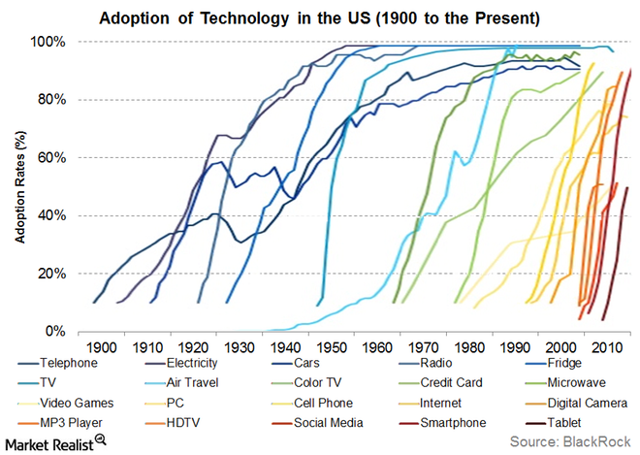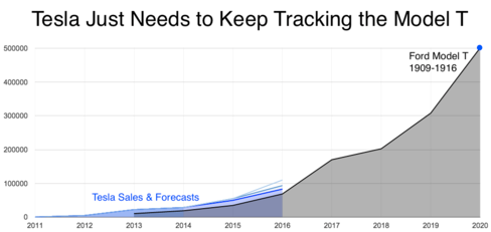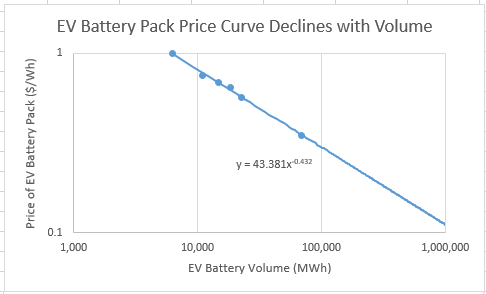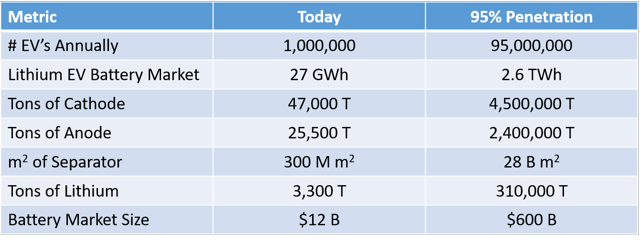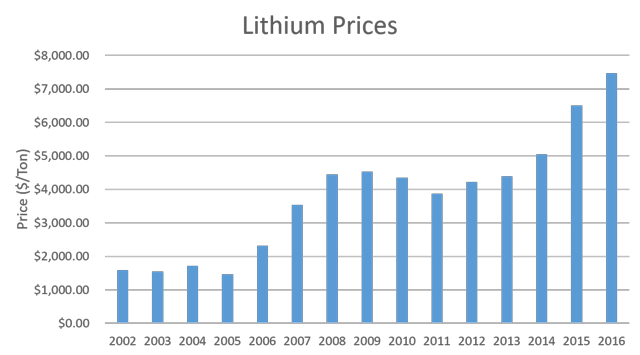http://seekingalpha.com/article/4028873-lithium-market-will-grow-20-times-current-size-next-15-years
The Lithium Market Will Grow To 20 Times Its Current Size In The Next 15 Years
Dec. 7, 2016 12:21 PM ET
Includes: ALB, FMC, LIT, TSLA
Brian Morin
Summary
Consumer adoption from 5% to 95% penetration is now taking 10 years.
It is actually very predictable how this will happen in electric vehicles, and the consequences are staggering.
At 95% penetration, the lithium market is 25 times larger than it is now, giving the opportunity for terrific returns if the right choices are made.
The top investments are Albemarle for lithium, Tesla as a specialized EV investment, and LIT X exchange-traded fund for broad exposure.
Recently, I asked myself, what will happen when electric vehicles are as common as cellular telephones? Meaning that everyone who has a car now has an electric vehicle instead of a gas vehicle. The answers are staggering.
But first, let's walk into it, and see if it makes any sense. Having a look at history, we see that consumer products take a certain amount of time to go from 5% to 95% penetration. That can be seen in the following graph.
In the early part of the last century, the time from 5% to 95% could be 30-40 years. But at the end, and in the 2000s, it is more like 10 years. The automotive industry may strain to achieve this, just because of the sheer mass of the industry, but let's run with a 10-15 year time frame.
How long until we attain 5%?
We are at 1% now, but much higher in places like China, Norway, Sweden, California, and other places. Here, I am talking about plug-in electric vehicles, not hybrids. There is one other graph that is worth looking at, which shows the Model T and Tesla (NASDAQ:TSLA) sales on the same graph.
Given that Tesla has already pre-sold 400,000 Model 3s, is soon to announce the crossover Model Y, and has a long list of new cars coming, it seems they will continue to track or exceed the Model T for at least the next several years. And we know where that led.
The last graph to consider as we ask how long until we attain 5% is the graph of battery costs versus cumulative volume shown below.
This shows that we have come down by a factor of 5 (from $1000/kWh to ~$200/kWh) since EVs were launched a few years ago. It is quite linear on the log-log graph, so we can expect that to continue. Volumes are increasing, so we are likely only a few years away from the bottom of the graph, where electric vehicles are not only better, but also less expensive.
After 5%, then what?
Once the electric vehicles obtain 5% market share, there is a certain social dynamic that happens. If you live in a neighborhood of 200 houses, then 10 of them will own electric vehicles. You will see them at the pool, at the store, in your work parking lot. People will talk about never going to the gas station, and when people are there, waiting for the guy in front to finally move his car, the thought of never going will be appealing. They will notice the gas station payments on their credit card and wonder what life would be without them. They will notice the gurgling and vibrations of their own engines as they idle at stop lights, in lines for fast food, while waiting in the car line at school. It just feels inferior, old technology, the dirty past. They will want the newest technology, in the same way that no one today would buy an HDTV, let alone an analog TV.
Think of this: today, if there is a guy riding a horse, we know the movie is about the distant past. In the future, if we see a gas station, or see a car chase that ends in a ball of fire, we will know we are watching a movie about the past. Later, the same will be true of steering wheels and a driver. People don't ride horses to work, and soon they will not drive vehicles that rely on thousands of moving parts controlling the burning of fossil fuels, riding on a tank of 20 gallons of explosive liquids that create great endings in action movies.
What Does the Market Look Like at Full Penetration?
This is the part that no one has thought about clearly, and those who have are disbelieving. Here are the numbers for automotive applications (today's numbers are according to AVICENNE):
Today, there are between 35,000 and 40,000 T of lithium produced annually. There are plenty of reserves, around 13 million T that are readily accessible (enough for 40 years of 100% EV production - or with some recycling, enough for an ongoing industry for 100s of years).
Looking Specifically at Lithium
Lithium production today goes to a few big buckets of applications, including lithium ion batteries, glass and ceramics, and grease and other applications, each taking roughly 1/3 of lithium production today, with approximately 12,000 T of lithium each. The other applications will grow only at the global GDP growth rate, just over 3%. In 15 years, the 24,000 T will become just under 40,000 T. In batteries, 3/4 are not in auto, and will likely grow at around 8%, going from 9,000 T to just under 30,000 T. Add to this the growth of automotive, from 3,300 T to 310,000 T, and you get a total growth of 35,000 T to 380,000 T, or 17% CAGR for the next 15 years. And that is with stable pricing.
Here is the historic lithium pricing:
Notice that the advent of volume production of electric vehicles happened somewhere in the 2013-14 time frame. Prices will likely go up, but not at the rate shown over the last couple years. However, it is reasonable to expect a 4% inflation of lithium pricing. Adding this to the lithium consumption of 17% and you get a market growth rate of 21%. When you do the math, that growth gives a market size in dollars that is 20 times as big as it is now.
Stocks to invest in
There are several ways to invest directly into lithium:
Global X Lithium (NYSEARCA:LIT): This is an exchange-traded fund that mirrors the Solactive Global Lithium Index, and focuses heavily on stocks that heavily use lithium, including FMC (NYSE:FMC), QUIMICA Y MINERA, EnerSys (NYSE:ENS), Albemarle (NYSE:ALB), Panasonic (OTCPKCRFY), Samsung SDI (OTC:SSDIY), LG Chem (OTC:LGCLF) and Tesla.
FMC Corp: FMC is a diversified chemical company with three divisions: agriculture, health, and lithium. Lithium accounts for about 10% of revenue and 15% of earnings, with about $280 million in annual revenue from lithium, compared to company revenue of $3.2 billion. It is benefiting from higher lithium prices.
Albemarle: ALB is a $2.9 billion specialty chemical company with three divisions: Lithium & Advanced Materials, Refining Solutions, and Bromine Solutions. It has acquired two lithium businesses in the last two years, and its annual revenue in lithium is $906 million, a much larger percentage of the total than for FMC.
Tesla: TSLA is a $5.9 billion automotive company with two electric vehicles, including the fastest production car on the road today. It will help to drive the use of lithium as a consumer but may face significant competition from the traditional automotive companies as dozens of competitive vehicles are scheduled to launch in the next few years.
Of these, the cleanest and broadest bet on the future growth of lithium is Albemarle, which will benefit no matter which EV manufacturer or segment eventually wins. Tesla is the clear leader now in electric vehicles but is a specialized investment play that may suffer from competitive offerings. LIT is a very broad and diversified investment, which will not have the growth of a more specialized investment in one of its higher growth components.
Disclosure: I am/we are long TSLA, LIT.
Lithium & Galaxy News
-
- There are more pages in this discussion • 107 more messages in this thread...
You’re viewing a single post only. To view the entire thread just sign in or Join Now (FREE)
Featured News
Add GXY (ASX) to my watchlist
Currently unlisted public company.
The Watchlist
LU7
LITHIUM UNIVERSE LIMITED
Alex Hanly, CEO
Alex Hanly
CEO
Previous Video
Next Video
SPONSORED BY The Market Online

